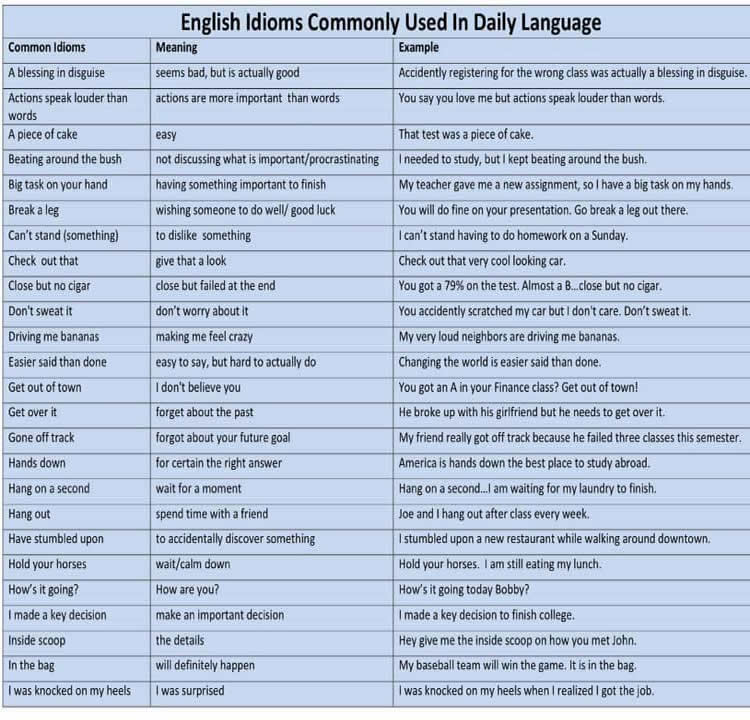Common Idioms
🧠 Why Teach Idioms?
Idioms are fixed expressions like “break the ice” or “under the weather” that have meanings different from the literal meanings of the individual words. They’re important because:
-
Idioms appear often in spoken and informal written English
-
They enrich vocabulary and help students sound more natural
-
Understanding idioms improves listening and reading comprehension
However, idioms are often difficult for ESL students because they can’t be translated word-for-word and don’t follow grammar rules clearly.
Go Here For My FREE Idioms Song and Worksheets. It is sent to your email with my other songs.
🧑🏫 How to Teach Idioms to ESL Students
1. Choose Relevant Idioms
Start with high-frequency, concrete, and contextual idioms—especially those used in everyday conversation, like:
-
It’s raining cats and dogs (raining heavily)
-
Hit the books (to study)
-
Piece of cake (easy)
-
Cost an arm and a leg (very expensive)
✅ Choose 5–10 idioms that relate to a theme (e.g., school, feelings, body, weather).
2. Teach Idioms in Context
Never teach idioms in isolation. Use stories, dialogues, or images to show the idiom in use.
✅ Example:
Sarah was nervous before the presentation, but her teacher told her to break a leg.
Ask: “What do you think that means? Was it literal?”
Encourage students to guess the meaning based on the context. This builds inference skills.
3. Break Down the Idiom
After context:
-
Explain the idiom’s meaning clearly
-
Give one or two more example sentences
-
Highlight if it’s formal or informal, and how it’s used grammatically
✅ Activity: Match idioms with their meanings or example sentences.
4. Encourage Usage
Provide chances for students to use the idioms:
-
Create a short dialogue using 2 idioms
-
Write a mini story or comic strip with 3 idioms
-
Use “Idiom of the Week” and challenge students to use it in conversation or writing
✅ Speaking games like “Idiom Charades” or “Guess the Idiom” are fun and effective.
5. Visuals Help
Idioms are more memorable when paired with images or gestures. Create visual flashcards or have students illustrate idioms.
✅ Tip: Let students draw or act out the literal and actual meanings to reinforce learning.
✏️ Teacher Tips
-
Avoid overwhelming students—teach a few idioms at a time
-
Recycle idioms regularly in reading, writing, and speaking tasks
-
Keep a class idiom wall or idiom journal for ongoing review
Go Here For My FREE Idioms Song and Worksheets. It is sent to your email with my other songs.
(image from trongduc25789)
Above are common idioms with meanings and examples.
A blessing in disguise, actions speak louder than words, a piece of cake, beating around the bush, break a leg, can’t stand it, check out that, close but no cigar, don’t sweat it, driving me bananas, easier said than done, get over it.
——————————————————————————————————————————–
📅 LESSON PLAN: Common Idioms
Level: Intermediate ESL
Time: 45–60 minutes
Focus: Vocabulary (Idioms), Listening, Speaking, Reading, Writing
Objectives
-
Understand the meanings of common idioms in context
-
Use idioms correctly in writing and speaking
-
Recognize idioms in reading and listening tasks
Materials
-
Idiom worksheet (included)
-
Idiom picture cards (included)
-
Whiteboard or projector
Warm-Up (5–10 mins)
-
Ask: “Do you know any strange English expressions? What do they mean?”
-
Share an idiom like “It’s a piece of cake” and ask students to guess what it means
Presentation (10 mins)
-
Show 5 idioms with meanings, images, and example sentences
-
Elicit ideas: What might this idiom mean?
Guided Practice (15 mins)
-
Use idiom picture cards and match them with definitions and example sentences
-
Students complete matching and gap-fill exercises from the worksheet
Speaking Practice (10 mins)
-
Students choose 2 idioms and create a short dialogue or mini-story in pairs
-
Present to the class or another pair
Wrap-Up (5 mins)
-
Review key idioms with a quick game: “Guess the Idiom” (teacher gives definition, students guess)
-
Assign homework: Use 3 idioms in a journal entry
🗋 WORKSHEET: Common Idioms Practice
Part A: Match the Idiom to Its Meaning
-
Break the ice
-
Under the weather
-
Cost an arm and a leg
-
Piece of cake
-
Hit the books
A. Easy to do
B. Study hard
C. Help people feel comfortable
D. Very expensive
E. Feeling sick
Write the correct match:
-
___ 2. ___ 3. ___ 4. ___ 5. ___
Part B: Fill in the Blank with the Correct Idiom
-
I stayed home today because I was feeling _____________________.
-
The new phone I want _____________________. I need to save money!
-
I have a test tomorrow. Time to _____________________.
-
Speaking English in front of the class helped _____________________.
-
Don’t worry about the exam. It will be a _____________________.
Part C: Create Your Own Dialogue
Use at least 2 idioms from the lesson in a short conversation between two people:
🎨 IDIOM PICTURE CARDS (Description)
Use these with flashcards or slides. Each card should show:
-
Idiom: Break the ice
Image: People meeting for the first time, someone telling a joke Meaning: To make people feel relaxed in a new situation -
Idiom: Under the weather
Image: Person in bed with tissues and a thermometer Meaning: To feel sick or unwell -
Idiom: Cost an arm and a leg
Image: Price tag with arms and legs drawn on it Meaning: Something very expensive -
Idiom: Piece of cake
Image: A cake and a thumbs-up sign Meaning: Something very easy -
Idiom: Hit the books
Image: A student surrounded by textbooks Meaning: To study hard
Tip: Laminate cards or show them in a digital slideshow for reuse.
Go Here For My FREE Idioms Song and Worksheets. It is sent to your email with my other songs.


